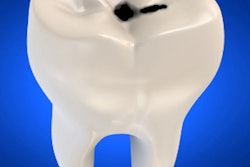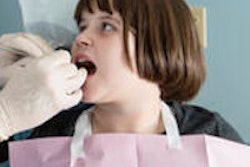
SAN FRANCISCO - Despite its flaws, silver diamine fluoride (SDF) may be the best option for arresting caries development in baby teeth. SDF was significantly more effective than fluoride varnish in preventing biofilm formation in a new study, presented at the International Association for Dental Research (IADR) annual meeting.
Researchers from New York University (NYU) were curious about how silver diamine fluoride would perform against topical fluoride varnish, one of the most common forms of preventive dental care. They found that SDF inhibited biofilm formation, while fluoride varnish had a minimal effect.
"SDF is a treatment that has been used for a long time," said presenter Simone Duarte, DDS, PhD, an associate professor at the NYU College of Dentistry. "It's not invasive; cost is very low. It's very easy to apply. There is no pain, no anesthesia. And it provides caries arrest, although this term is disputed, for six months."
SDF versus fluoride varnish
 Drs. Simone Duarte, left, and Yihong Li, right, at the IADR 2017 conference.
Drs. Simone Duarte, left, and Yihong Li, right, at the IADR 2017 conference.Although researchers know that SDF halts caries development, they aren't sure how that process works. The NYU team, which includes Dr. Duarte and principal investigator Yihong Li, DDS, MPH, DrPH, wanted to study whether SDF could inhibit biofilm formation. The researchers also wanted to compare the efficacy of SDF against topical fluoride varnish.
Using 15 deciduous molars with deep carious lesions, the researchers tested their theory that SDF would significantly inhibit biofilm formation. They split the teeth perpendicularly, treating one half of the clean lesions with either SDF or fluoride varnish, and leaving the other half of the lesions untreated. Five teeth received fluoride varnish, and the remaining 10 received SDF.
The molars were then incubated in a solution of Streptococcus mutans bacteria and sucrose for two weeks. The researchers compared the resulting biofilms using microscopy.

The teeth treated with SDF had significantly thinner biofilm compared with the untreated teeth. Fluoride varnish, however, did not prove to be a significant intervention compared with no treatment at all.
"The SDF prevented biofilm formation. ... The biofilm was actually very low," Dr. Duarte said. With fluoride varnish, the teeth had a very similar biofilm to the untreated teeth in terms of thickness, he added.
The unknown about SDF
One of the main limitations of the study was that it included a small number of extracted teeth, only five of which were treated with fluoride varnish, according to the study researchers. In addition, SDF stains teeth, so although it may work better than varnish, it still may not be a practical solution. Although Dr. Duarte said she has noticed that dentists tend to have more of a problem with black teeth than patients.
Dr. Duarte also noted that this is just the beginning of SDF research. While the scientific community knows that it arrests caries development, researchers are still studying how the process works. The goal is to create a version that can prevent biofilm formation without staining teeth.
"We're looking into how the silver actually penetrates. We are showing that silver ... actually penetrates into the dentin and goes very deep," she said. "We don't know how long it stays there or how long it will be active, but that's being studied as well."



















